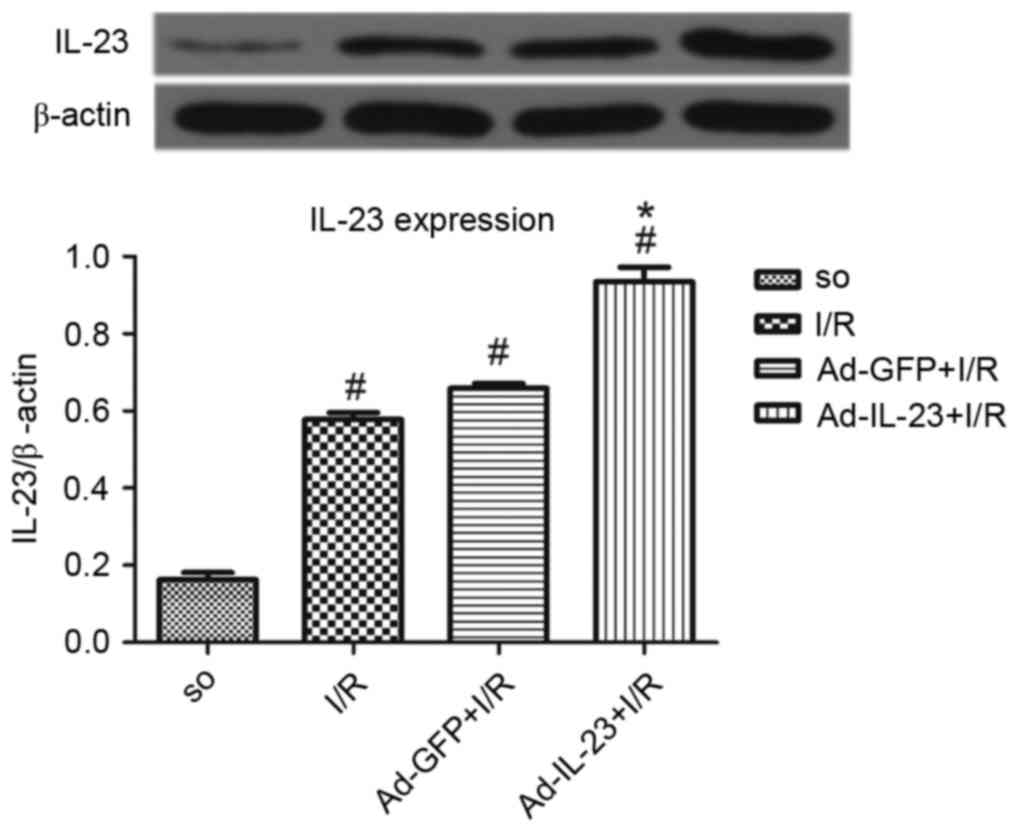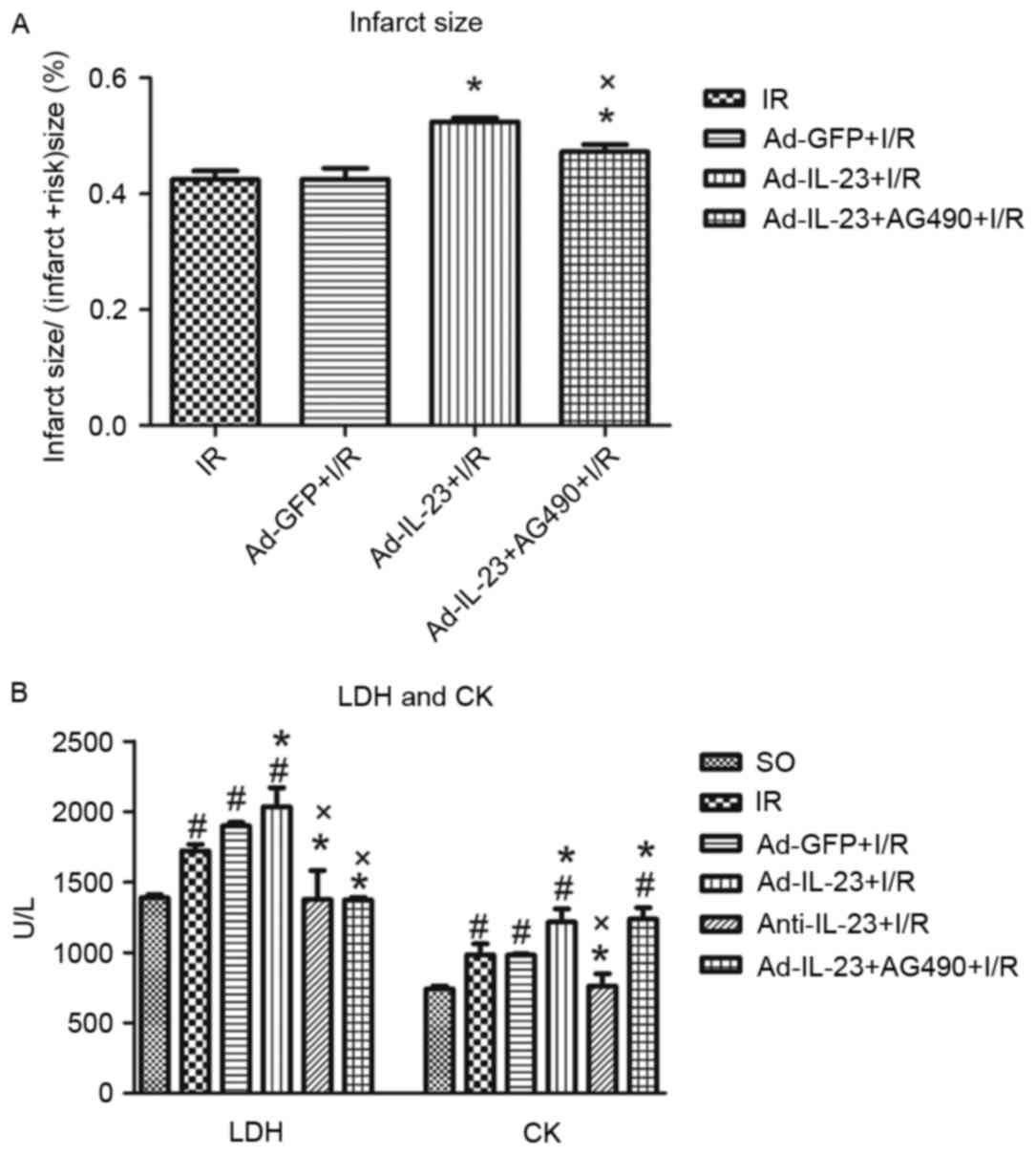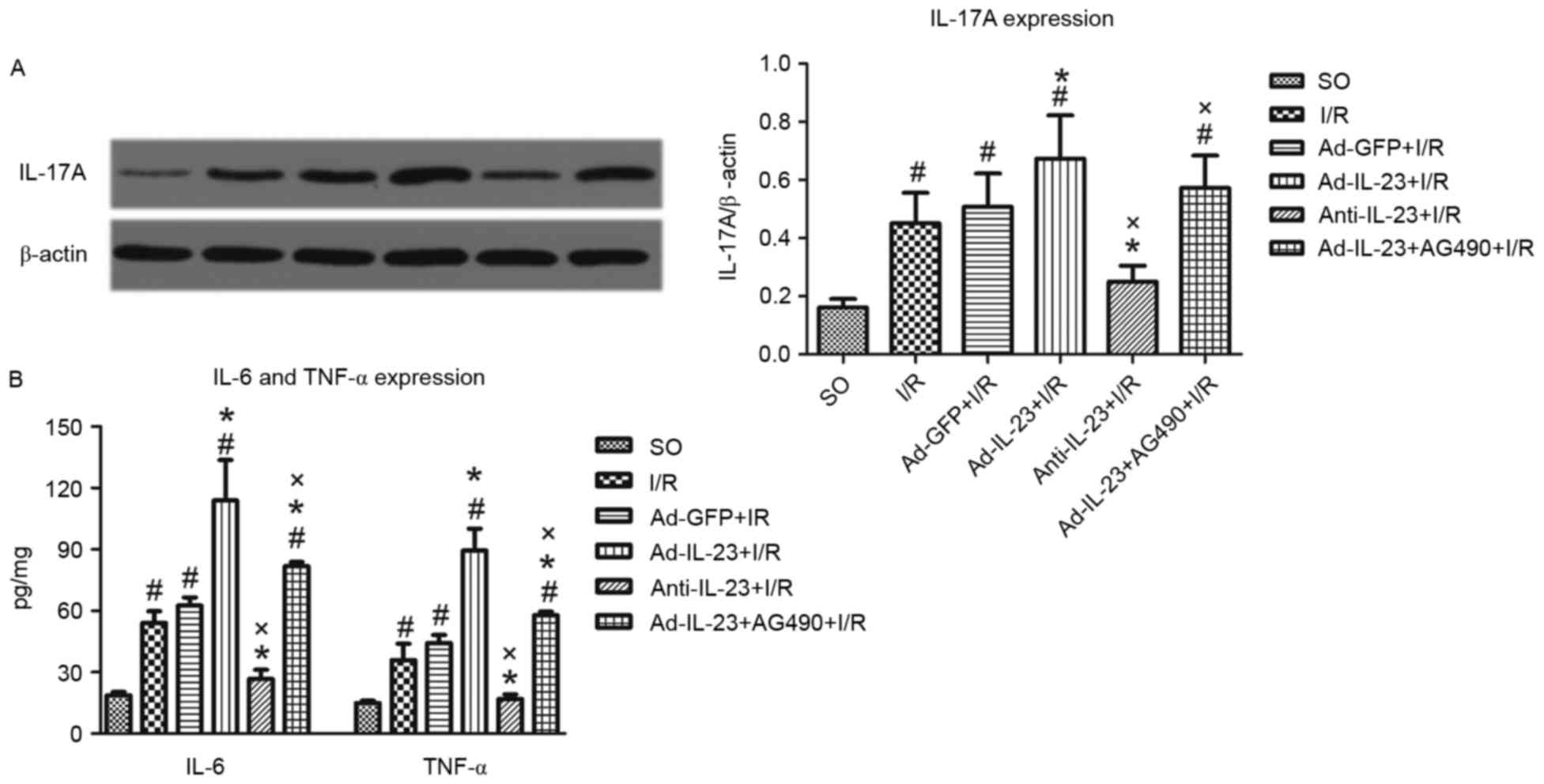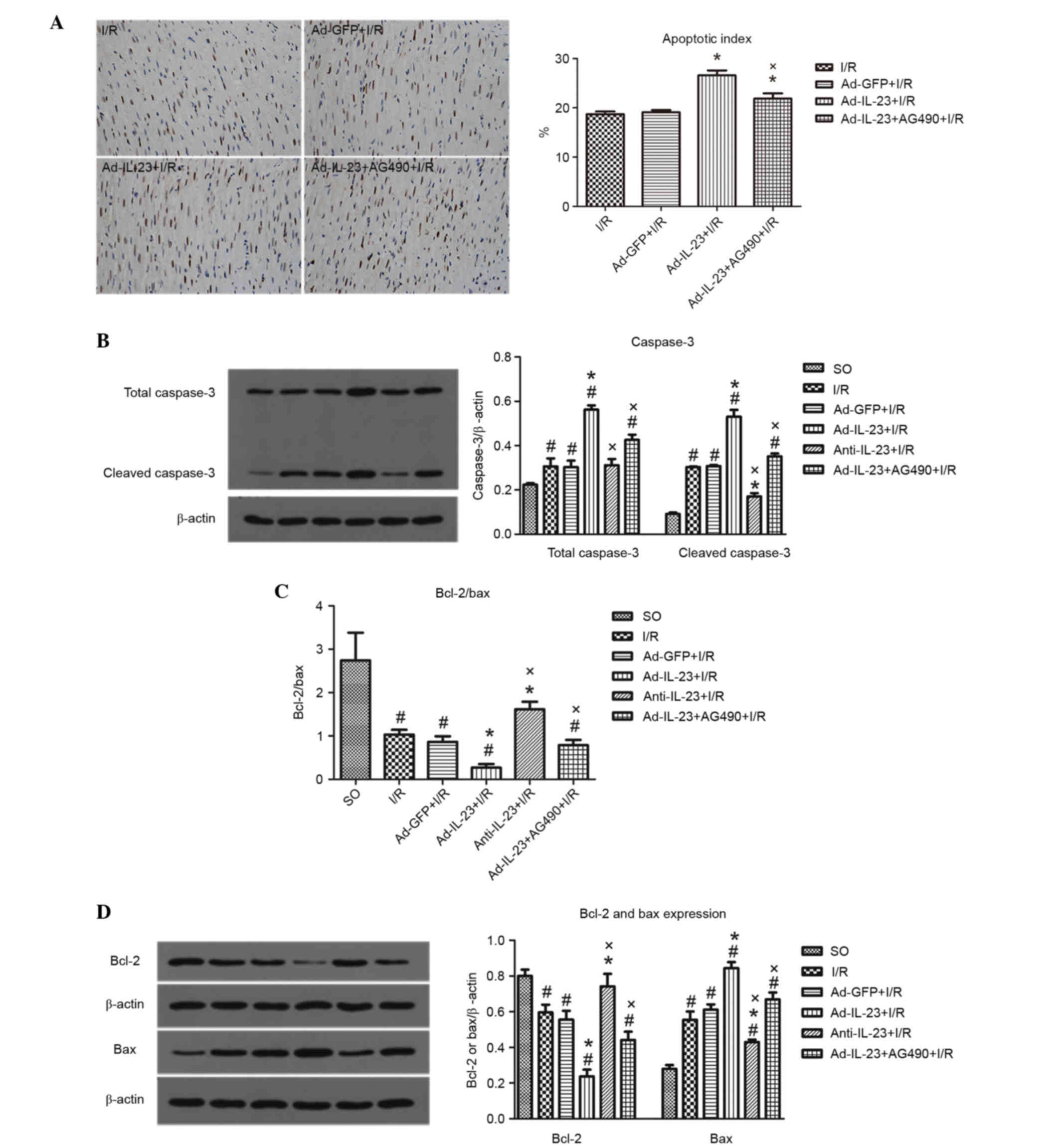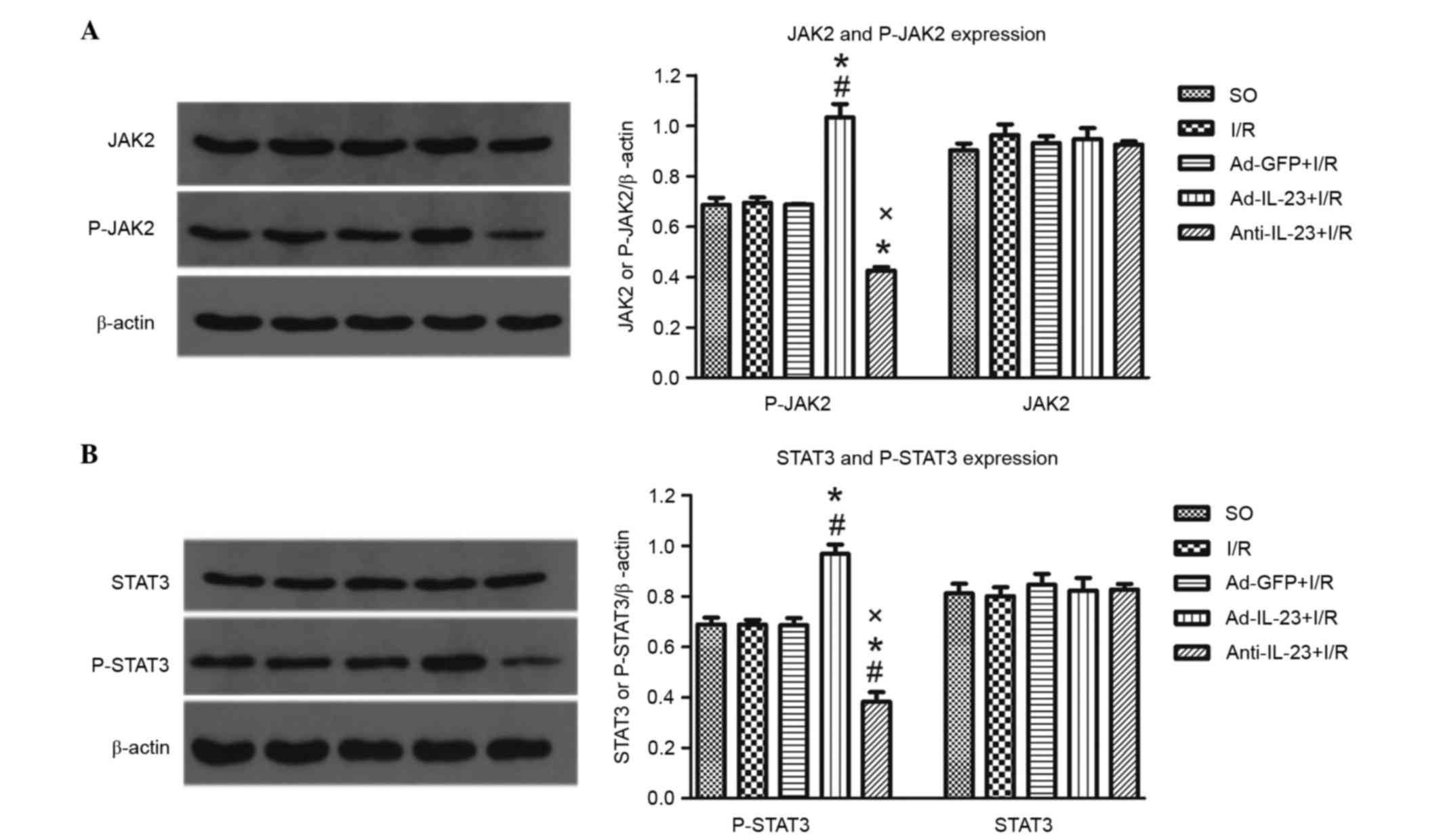Promoting effects of IL‑23 on myocardial ischemia and reperfusion are associated with increased expression of IL‑17A and upregulation of the JAK2‑STAT3 signaling pathway
- Authors:
- Published online on: October 12, 2017 https://doi.org/10.3892/mmr.2017.7771
- Pages: 9309-9316
-
Copyright: © Liao et al. This is an open access article distributed under the terms of Creative Commons Attribution License.
Abstract
Introduction
Myocardial infarction is a serious disease, which contributes to high mortality rates in modern society. Myocardial reperfusion therapies, including percutaneous coronary intervention, thrombolytic therapy and coronary artery bypass grafts, have been regarded as the most effective approaches for rescuing ischemic myocardial tissue. However, regardless of the type of effective reperfusion therapy used for myocardial infarction, reperfusion itself can cause further myocardial injury, which can even attenuate the therapeutic benefit (1). Myocardial I/R can induce local myocardial inflammation, including promoting the release of various cytokines, including interleukin (IL)-17A, tumor necrosis factor-α (TNF-α) and IL-6, and promoting the activation of inflammatory cells, including neutrophils, which is one of the crucial pathophysiological processes in myocardial I/R injury (2–4). Apoptosis is another pathological result of myocardial I/R, which can result in reversible or irreversible damage of myocardial tissue, accompanied with the inflammatory processes mentioned above (5).
IL-23, as a newly-identified member of the IL-12 family, has attracted increased attention (6). IL-23, predominantly produced by activated macrophages and dendritic cells, is a heterodimeric cytokine composed of IL-23p19 and IL-12/IL-23p40 subunits (7). Previous studies have confirmed that IL-23, as a pro-inflammatory cytokine, is critical in infections, autoimmune diseases, tumors and inflammatory diseases, including myocardial I/R injury, by promoting the expression of inflammatory cytokines and inflammatory responses (8–11). IL-17A, expressed at high levels in myocardial I/R injury, has been described as a downstream pro-inflammatory cytokine. The inhibition of IL-17A release can reduce myocardial I/R injury and improve cardiac function (12). Studies have also indicated that IL-23 can regulate the expression of IL-17A (8,11). The present study attempted to test the hypothesis that IL-23 aggravates myocardial I/R injury by promoting inflammatory responses and myocardial apoptosis, which may be associated with the high expression of IL-17A and upregulation of the Janus kinase 2/signal transducers and activators of transcription 3 (JAK2-STAT3) signaling pathway.
Materials and methods
Construction of adenovirus (Ad) vectors
IL-23 and empty plasmid Ads (termed Ad-IL-23 and Ad-GFP) were constructed by cloning the IL-23 cDNA or empty plasmid. The recombinant viruses were then amplified in HEK 293 cells (American Type Culture Collection, Manassas, VA, USA) by transfection and finally purified using an Adeno-X™ purification kit (Microbix Biosystems, Toronto, ON, Canada) in order to reach the titer of 1011 pfu/ml.
Animal preparation and experimental design
All experimental protocols conformed to the Guideline for the Care and Use of Laboratory Animals published by the US National Institutes of Health (NIH Publication, revised 1996) (13) and were approved by the Renmin Hospital of Wuhan University Animal Care and Use Committee (Wuhan, China). Male Sprague-Dawley rats (200–250 g) were supplied by the Experimental Animal Center of Vital River Laboratories (Beijing, China) and randomly assigned into the following six treatment groups: Group 1, sham-operated control (SO; n=10) rats subjected to surgery without myocardial ischemia; group 2, I/R (n=10) rats subjected to occlusion of the left anterior descending coronary artery (LAD) for 30 min, followed by reperfusion for 4 h; group 3, Ad-GFP+I/R (n=6) rats treated with Ad-GFP (1011 pfu/ml, 100 µl per rat, intramyocardially) for 72 h prior to LAD occlusion; group 4, Ad-IL-23+I/R (n=6) rats treated with Ad-IL-23 (1011 pfu/ml, 100 µl per rat, intramyocardially) for 72 h prior to LAD occlusion; group 5, anti-IL-23+I/R (n=6) rats treated with anti-IL-23 neutralized monoclonal antibodies (200 µg per rat, i.v. into the tail vein) from Biosynthesis Biotechnology Co., Ltd. (Beijing, China) 30 min prior to LAD occlusion; group 6, Ad-IL-23+AG490+I/R (n=6) rats treated with Ad-IL-23 (1011 pfu/ml, 100 µl per rat, intramyocardially) for 72 h and injection of AG490 (an inhibitor of JAK2-STAT3) from MedChemExpress USA (Monmouth Junction, NJ, USA; 3 mg/kg, i.v. into tail vein), 30 min prior to LAD occlusion.
Sodium pentobarbital (2.5%; 45 mg/kg, i.p.) was used as the anesthetic in surgery. The I/R used in the rats model was performed, as previously described (14). Changes in ST segment elevation in Leads-II and regional cyanosis of the myocardial surface were considered to be signs of successful establishment of the myocardial I/R model. Subsequently, a half dose (22.5 mg/kg, i.p.) of 2.5% sodium pentobarbital was injected into the postoperative rats. Samples, including 2 ml of blood from the jugular vein and heart tissue in the infarct area (white) and risk area (5 mm around the infarct area) were obtained immediately and frozen at −80°C for subsequent assays.
Assessment of myocardial injury
A previously described double-staining technique was used to determine the infarct size (14). In brief, following 4 h reperfusion, the LAD was occluded again and 2 ml Evans Blue dye (1%; Sigma-Aldrich; Merck Millipore, Darmstadt, Germany) was injected via the jugular vein. The heart was excised and frozen at −80°C for 15 min, and was then cut into 1.5 mm transverse sections from the apex to the base, which were subsequently incubated in 1.0% 2,3,5-triphenyltetrazolium chloride (TTC; Sigma-Aldrich; Merck Millipore) for 15 min at 37°C. The sizes of the infarct area (white) and the area at risk (red and white) were measured using an image analyzer (Image-Pro Plus 3.0; Media Cybernetics, Inc., Silver Spring, MD, USA). The percentage of the risk area volume (% infarct area/risk + infarct area) was used to determine the infarct size.
The serum levels of lactate dehydrogenase (LDH) and creatine kinase (CK) were measured in the blood samples, which were collected, centrifuged (2,050 × g, 5 min, 4°C) and stored at −20°C until analyses. Standard techniques using commercialized assay kits were used according to the manufacturer's protocol (Nanjing Jiancheng Bioengineering Institute, Najing, China) for the analyses. Values are expressed in international units (IU) per liter.
Assessment of myocardial inflammatory parameters
The levels of TNF-α and IL-6 in myocardial tissues were measured using commercial enzyme-linked immunosorbent assay kits (TNF-α and IL-6; Nanjing Jiancheng Bioengineering Institute) according to the manufacturer's protocol. The sensitivity of the assay was 1 pg/ml.
Cardiac myocyte protein concentrations were measured using western blot assays as described previously (15). In brief, total protein content was determined using a bicinchoninic acid protein assay kit (Beyotime Institute of Biotechnology, Haimen, China) according the manufacturer's protocol. Protein extracts (40 µg) of the cardiac tissues in radioimmuno-precipitation assay lysis buffer (Beyotime Institute of Biotechnology) were separated by 10% sodium dodecyl sulfate-polyacrylamide gel electrophoresis, transferred onto polyvinylidene difuoride membranes (EMD Millipore, Billerica, MA, USA) and probed with primary antibodies at 4°C overnight, including anti-IL-23 (cat no. bs-1193R; diluted 1:300; Beijing Bioss Biological Co., Ltd., Beijing, China), anti-IL-17A (cat no. bs-1183R; diluted 1:300; Beijing Bioss Biological Co., Ltd, Beijing, China) and β-actin (cat no. BM0627; diluted 1:500; Wuhan Boster Bioengineering Co, Ltd., Wuhan, China). Following incubation with the appropriate secondary antibodies (The horseradish peroxidase-conjugated mouse IgG (cat no. BA1051); The horseradish peroxidase-conjugated rabbit IgG (cat no. BA1054); diluted 1:50,000; Wuhan Boster Bioengineering Co, Ltd.) for 2 h at room temperature, the specific bands were visualized using an ECL detection system according to the manufacturer's protocol.
Assessment of myocardial apoptosis
Myocardial apoptosis was examined using the TdTmediated dUTP nick-end labeling (TUNEL) assay, as described previously (16). In brief, following being fixed in 4% paraformaldehyde and embedded in paraffin, the myocardial tissue samples were cut into 5 µm blocks. The percentages of apoptotic cells were evaluated in the five slides of each block using the TUNEL assay. Subsequently, five fields (magnification, ×200) were randomly selected on each section under a light microscope (Leica Microsystems, Inc., Buffalo Grove, IL, USA). Cells (positive brown cells and normal blue cells) were counted using the MIAS 4.0 medical image analysis system (Beijing Bingyang Keji Corporation, Beijing, China). The apoptosis index (positive cells/total cells × 100%) was used to express myocardial apoptosis.
The levels of B-cell lymphoma 2 (Bcl-2), Bcl-2-associated X protein (Bax) and caspase-3 in myocardial tissues were assessed using western blot assays, as mentioned above. Anti-Bcl-2 ((cat no. sc-7382; diluted 1:1,000; Santa Cruz Biotechnology, Inc., Dallas, TX, USA), anti-Bax (cat no. BS6420; diluted 1:1,000; Bioworld Technology, Minneapolis, MN, USA) and anti-caspase-3 (cat no. 19677-1-AP; diluted 1:1,000; Wuhan Mitaka Biotechnology Co, Ltd., Wuhan, China) were used as primary antibodies (4°C, overnight), and the secondary antibodies were as described above (cat no. BA1051; cat no. BA1054).
Assessment of JAK2-STAT3 signaling pathway activation
The levels of JAK2, phosphorylated (P-)JAK2, STAT3 and P-STAT3 were assessed using western blot assays, as mentioned above. Anti-JAK2 (cat no. sc-21870; diluted 1:1,000; Santa Cruz Biotechnology, Inc.), anti-P-JAK2 (cat no. bs-3206R; diluted 1:200; Beijing Bioss Biological Co., Ltd.), anti-STAT3 (cat no. sc-483; diluted 1:500; Santa Cruz Biotechnology, Inc.) and anti-P-STAT3 (cat no. BS4181; diluted 1:800; Bioworld Technology) were used as primary antibodies (4°C, overnight). And the secondary antibodies were the horseradish peroxidase-conjugated mouse IgG (cat no. BA1051), the horseradish peroxidase-conjugated rabbit IgG (cat no. BA1054) and the horseradish peroxidase-conjugated goat IgG (cat no. BA1060); diluted 1:50,000; Wuhan Boster Bioengineering Co, Ltd..
Statistical analysis
Statistical analysis was performed using SPSS 17.0 (SPSS, Inc., Chicago, IL, USA). All values are expressed as the mean ± standard deviation. Student's t-test was used for between-group comparisons. One-way analysis of variance or a Welch test was used for comparisons among groups, and Tukey's post hoc test was used for multiple comparisons. P<0.05 was considered to indicate a statistically significant difference.
Results
Myocardial expression of IL-23 during myocardial I/R
Compared with the SO group, the I/R group had a significantly higher expression level of IL-23 (0.578±0.018, vs. 0.163±0.018; P<0.05). The level of IL-23 in the Ad-IL-23 group was significantly increased, compared with that in the I/R group (0.935±0.038; P<0.05). However, no significant difference was found between the Ad-GFP group and I/R group (0.659±0.013; P>0.05; Fig. 1).
IL-23 promotes myocardial injury following I/R
Compared with the I/R group, the infarct size in the Ad-IL-23 group was significantly increased (52.4±0.7, vs. 42.4±1.5%; P<0.05). However, no significant difference was found between the Ad-GFP group and I/R group (42.5±1.9%; P>0.05). The addition of AG490 significantly inhibited the effect of Ad-IL-23 with regard to decreasing infarct size, compared with that in the Ad-IL-23 group (47.2±1.3%; P<0.05; Fig. 2A).
Following 4 h reperfusion, the levels of LDH (1,721.2±106.1 U/l) and CK (985.2±172.3 U/l) in the I/R group were significantly increased (P<0.05), compared with that in the SO group. However, no significant difference was found between the Ad-GFP group and I/R group in LDH (1,899.0±44.0 U/l) or CK (981.5±17.1 U/l; P>0.05). Ad-IL-23 increased the high expression levels of LDH (2,035.4±270.4 U/l) and CK (1215.7±187.5 U/l) induced by myocardial I/R (P<0.05) compared with the I/R group. However, the levels of LDH (1,376.6±411.1 U/l) and CK (762.2±175.5 U/l) in the anti-IL-23 group were decreased, compared with those in the I/R group (P<0.05). Furthermore, the addition of AG490 partially inhibited the effect of Ad-IL-23 with regard to decreasing the expression level of LDH (1,374.1±27.3 U/l) compared with that in the Ad-IL-23 group (P<0.05; Fig. 2B).
IL-23 intensifies inflammatory responses
Compared with the SO group, a higher expression level of IL-17A was observe in the I/R group (0.451±0.105, vs. 0.160±0.030; P<0.05). Ad-IL-23 enhanced the increased expression of IL-17A induced by myocardial I/R (0.673±0.149; P<0.05). However, anti-IL-23 significantly inhibited the I/R-induced increase of IL-17A (0.250±0.055; P<0.05). Furthermore, the addition of AG490 significantly inhibited the effect of Ad-IL-23 (0.572±0.112; P<0.05; Fig. 3A.
Following 4 h reperfusion, the levels of TNF-α (35.9±14.0 pg/mg) and IL-6 (54.1±9.8 pg/mg) were significantly increased (P<0.05), compared with those in the SO group. Ad-IL-23 increased the high expression levels of TNF-α (89.5±18.5 pg/mg) and IL-6 (113.9±34.3 pg/mg) induced by myocardial I/R (P<0.05). However, anti-IL-23 decreased the expression levels of TNF-α (17.0±3.8 pg/mg) and IL-6 (26.7±7.8 pg/mg), compared with those in the I/R group (P<0.05). Furthermore, the addition of AG490 significantly inhibited the effect of Ad-IL-23 with regard to decreasing the expression levels of TNF-α (57.8±3.0 pg/mg) and IL-6 (81.9±3.4 pg/mg), compared with those in Ad-IL-23 group (P<0.05; Fig. 3B.
IL-23 accelerates myocardial apoptosis
Ad-IL-23 significantly increased the I/R-induced myocardial apoptosis (26.6±1.0, vs. 18.7±0.5%; P<0.05), however, its effect was inhibited by AG490 (21.9±1.1%; P<0.05; Fig. 4A.
Following 4 h reperfusion, the levels of total caspase-3 (0.306±0.062) and cleaved caspase-3 (0.303±0.006) were significantly increased (P<0.05), compared with those in the SO group. Ad-IL-23 significantly increased the high expression levels of total caspase-3 (0.562±0.033) and cleaved caspase-3 (0.530±0.055) induced by myocardial I/R (P<0.05). However, anti-IL-23 decreased the I/R-induced high level of cleaved caspase-3 (0.171±0.026, P<0.05) but not total caspase-3 (0.312±0.049; P>0.05). The effects of Ad-IL-23 on total caspase-3 (0.426±0.041) and cleaved caspase-3 (0.352±0.022) were inhibited by AG490 (P<0.05; Fig. 4B.
Compared with the SO group, the I/R group had a lower ratio of Bcl-2 to Bax (1.03±0.11, vs. 2.74±0.64; P<0.05). However, the ratio was even lower in the Ad-IL-23 group (0.27±0.08; P<0.05), and the addition of AG490 significantly inhibited the effect of Ad-IL-23 (0.79±0.01; P<0.05). The ratio of Bcl-2 to Bax in the anti-IL-23 group was significantly higher, compared with that in the I/R group (1.62±0.17; P<0.05; Fig. 4C. The expression levels of Bcl-2 showed the same trend, whereas the expression of Bax showed an opposite trend to that of Bcl-2 (Fig. 4D).
IL-23 regulates the JAK2-STAT3 signaling pathway
Compared with the I/R group, the Ad-IL-23 group had significantly higher (P<0.05) expression levels of P-JAK2 (1.033±0.092, vs. 0.695±0.036) and P-STAT3 (0.968±0.063, vs. 0.687±0.033), however, this not the case with total JAK2 (0.948±0.074, vs. 0.963±0.074) or STAT3 (0.823±0.086, vs. 0.800±0.061; P>0.05). The levels of P-JAK2 and P-STAT3 in the anti-IL-23 group were significantly lower, compared with those in the I/R group (0.426±0.023 and 0.383±0.066, respectively; P<0.05; Fig. 5A and B).
Discussion
Myocardial inflammation is one of the crucial pathophysiological processes in myocardial I/R injury, which can be promoted by the release of various cytokines. The inflammatory responses ultimately aggravate tissue injury (17). Previous studies have demonstrated that the components of adaptive immunity and innate immunity are involved in myocardial I/R injury (18). The heterodimeric cytokine IL-23, primarily secreted by activated dendritic cells and macrophages, functions as a link between innate and adaptive immunity by promoting the proliferation of immune cells and secretion of cytokines (19).
In the present study, it was found that I/R significantly increased the expression of IL-23 in myocardial tissues, which was consistent with the findings of previous studies, indicating that macrophages can rapidly respond to endogenous stimulating factors following tissue injury and have a pathogenic role through their secretion of pro-inflammatory factors (20,21).
In the present study, it was found that IL-23 promoted inflammatory responses via increasing the expression levels of TNF-α and IL-6 in myocardial I/R. Previous studies have demonstrated that IL-23 is important in several inflammatory diseases, including myocardial I/R injury (8–11). Once released from activated dendritic cells and macrophages, IL-23 functions as a pro-inflammatory stimulus, which induces the differentiation of naive lymphocytes, including CD4+ T cells, and the secretion of inflammatory cytokines, including IL-1β, IFN-γ, TNF-α and IL-6 (8,22–24), indicating that IL-23 may reinforce the inflammatory process and intensify myocardial I/R injury through this mechanism.
The present study also found that the upregulation of IL-23 significantly increased the expression level of IL-17A. As an early pro-inflammatory cytokine, IL-17A is crucial in myocardial I/R injury (12,25). Previous studies have suggested that, in addition to directly aggravating myocardial I/R injury, IL-17A stimulates endothelial cells and macrophages, and increases the secretion of pro-inflammatory cytokines, including IL-1, IL-6, TNF-α and c-reactive protein, which further reinforces the inflammatory response and myocardial I/R injury (12). In addition, IL-17A can regulate the expression of granulocyte colony stimulating factor and chemokines, including CXC motif chemokine ligand (CXCL)l, CXCL5 and IL-18, to amplify and collect neutrophils, which may be another mechanism promoting myocardial inflammation and injury (12). Li et al (25) demonstrated that the expression of IL-17A was increased in myocardial I/R, and that the inhibition of IL-17A with anti-IL-17A significantly reduced levels of cardiac troponin T and myocardial infarct size, ameliorateing myocardial I/R injury. These results suggested that IL-23 may promote inflammatory responses and myocardial I/R injury by accelerating the secretion of IL-17A. Previous studies have demonstrated that the generation of IL-17A induced by IL-23 is mediated by activation of the JAK2, phosphoinositide 3-kinase/AKT, nuclear factor-κB and STAT3 signaling pathways (26–29), which may also be pathways through which IL-23 regulates the expression of IL-17A in myocardial I/R, although the precise mechanism remains to be elucidated.
Apoptosis is another important pathophysiological process during myocardial I/R, and a previous study found that the inhibition of apoptosis protected the heart from I/R injury (30). The present study found that IL-23 significantly reduced the ratio of Bcl-2 to Bax and increased the apoptotic index, indicating that IL-23 accelerated myocardial apoptosis during I/R injury. Liao et al (12) suggested that the upregulation (exogenous IL-17A treatment) or downregulation (anti-IL-17A monoclonal antibody treatment or IL-17A-knockout) of IL-17A markedly affected the severity of I/R injury through mediating cardiomyocyte apoptosis and neutrophil infiltration. Another study (11) reported that IL-17A, as a downstream pro-inflammatory cytokine, can regulate cardiomyocyte apoptosis. Therefore, it was hypothesized that IL-23 aggravates cardiomyocyte apoptosis by regulating the release of IL-17A. In the present study, it was demonstrated that IL-23 had a promoting effect in myocardial I/R injury via regulation of the expression of IL-17A, which is an novel finding, although previous studies have demonstrated that the IL-23/IL-17A axis is important in several inflammatory diseases and I/R in other organs (25,31,32).
In the present study, it was found that IL-23 activated the JAK2-STAT3 signaling pathway, and inhibiting this pathway suppressed the pro-inflammatory and pro-apoptotic effects of IL-23. The JAK2-STAT3 signaling pathway is a primary downstream signaling pathway of IL-23, which is an important signaling pathway in various cardiovascular diseases, including myocardial I/R injury (33–35). Previous studies have demonstrated that, once activated by IL-23, the JAK2-STAT3 pathway induces the activation and differentiation of memory T cells, including CD4+ T cells, into IL-17A secretory cells (Th17/Thil-17) and upregulates the secretion of IL-17A (36). In addition to IL-17A, activated memory T cells can secrete a mass of pro-inflammatory factors, including IL-6 and TNF-α, which are also crucial cytokines in the inflammatory process of myocardial I/R injury (22–25). The promoting effects of IL-17A in myocardial I/R injury suggested that the JAK2-STAT3 signaling pathway may be involved in IL-17A release and the promoting effects of IL-23 in myocardial I/R injury.
In conclusion, the present study suggested that IL-23 promoted myocardial I/R injury by increasing inflammatory responses and myocardial apoptosis, which may be associated with high expression levels of IL-17A and upregulation of the JAK2-STAT3 signaling pathway.
Acknowledgements
This study was supported by grants from the National Natural Science Foundation of China (grant nos. 81500274 and 81370308) and the Natural Science Foundation of Hubei Province (grant no. 2015CFB207).
References
|
Yellon DM and Hausenloy DJ: Myocardial reperfusion injury. N Engl J Med. 357:1121–1135. 2007. View Article : Google Scholar : PubMed/NCBI | |
|
Andrassy M, Volz HC, Igwe JC, Funke B, Eichberger SN, Kaya Z, Buss S, Autschbach F, Pleger ST, Lukic IK, et al: High-mobility group box-1 in ischemia-reperfusion injury of the heart. Circulation. 117:3216–3226. 2008. View Article : Google Scholar : PubMed/NCBI | |
|
Xiong J, Xue FS, Yuan YJ, Wang Q, Liao X and Wang WL: Cholinergic anti-inflammatory pathway: A possible approach to protect against myocardial ischemia reperfusion injury. Chin Med J (Engl). 123:2720–2726. 2010.PubMed/NCBI | |
|
Yang M, Chen J, Zhao J and Meng M: Etanercept attenuates myocardial ischemia/reperfusion injury by decreasing inflammation and oxidative stress. PLoS One. 9:e1080242014. View Article : Google Scholar : PubMed/NCBI | |
|
Frangogiannis NG, Smith CW and Entman ML: The inflammatory response in myocardial infarction. Cardiovasc Res. 53:31–47. 2002. View Article : Google Scholar : PubMed/NCBI | |
|
Oppmann B, Lesley R, Blom B, Timans JC, Xu Y, Hunte B, Vega F, Yu N, Wang J, Singh K, et al: Novel p19 protein engages IL-12p40 to form a cytokine, IL-23, with biological activities similar as well as distinct from IL-12. Immunity. 13:715–725. 2000. View Article : Google Scholar : PubMed/NCBI | |
|
Yannam GR, Gutti T and Poluektova LY: IL-23 in infections, inflammation, autoimmunity and cancer: Possible role in HIV-1 and AIDS. J Neuroimmune Pharmacol. 7:95–112. 2012. View Article : Google Scholar : PubMed/NCBI | |
|
Langrish CL, Chen Y, Blumenschein WM, Mattson J, Basham B, Sedgwick JD, McClanahan T, Kastelein RA and Cua DJ: IL-23 drives a pathogenic T cell population that induces autoimmune inflammation. J Exp Med. 201:233–240. 2005. View Article : Google Scholar : PubMed/NCBI | |
|
Morrison PJ, Ballantyne SJ and Kullberg MC: Interleukin-23 and T helper 17-type responses in intestinal inflammation: From cytokines to T-cell plasticity. Immunology. 133:397–408. 2011. View Article : Google Scholar : PubMed/NCBI | |
|
Yao J, Liu L and Yang M: Interleukin-23 receptor genetic variants contribute to susceptibility of multiple cancers. Gene. 533:21–25. 2014. View Article : Google Scholar : PubMed/NCBI | |
|
Zhu H, Li J, Wang S, Liu K, Wang L and Huang L: Hmgb1-TLR4-IL-23-IL-17A axis promote ischemia-reperfusion injury in a cardiac transplantation model. Transplantation. 95:1448–1454. 2013. View Article : Google Scholar : PubMed/NCBI | |
|
Liao YH, Xia N, Zhou SF, Tang TT, Yan XX, Lv BJ, Nie SF, Wang J, Iwakura Y, Xiao H, et al: Interleukin-17A contributes to myocardial ischemia/reperfusion injury by regulating cardiomyocyte apoptosis and neutrophil infiltration. J Am Coll Cardiol. 59:420–429. 2012. View Article : Google Scholar : PubMed/NCBI | |
|
Research NRCU: Guide for the care and use of laboratory animals. National academies press (US); Washington (DC): 1996 | |
|
Hu X, Cui B, Zhou X, Xu C, Lu Z and Jiang H: Ethyl pyruvate reduces myocardial ischemia and reperfusion injury by inhibiting high mobility group box 1 protein in rats. Mol Biol Rep. 39:227–231. 2012. View Article : Google Scholar : PubMed/NCBI | |
|
Xu H, Su Z, Wu J, Yang M, Penninger JM, Martin CM, Kvietys PR and Rui T: The alarmin cytokine, high mobility group box 1, is produced by viable cardiomyocytes and mediates the lipopolysaccharide-induced myocardial dysfunction via a TLR4/phosphatidylinositol 3-kinase gamma pathway. J Immunol. 184:1492–1498. 2010. View Article : Google Scholar : PubMed/NCBI | |
|
Ni J, Hu G, Xiong J, Shen J, Shen J, Yang L, Tang M, Zhao Y, Ying G, Yu G, et al: Involvement of interleukin-17A in pancreatic damage in rat experimental acute necrotizing pancreatitis. Inflammation. 36:53–65. 2013. View Article : Google Scholar : PubMed/NCBI | |
|
Steffens S, Montecucco F and Mach F: The inflammatory response as a target to reduce myocardial ischaemia and reperfusion injury. Thromb Haemost. 102:240–247. 2009.PubMed/NCBI | |
|
Linfert D, Chowdhry T and Rabb H: Lymphocytes and ischemia-reperfusion injury. Transplant Rev (Orlando). 23:1–10. 2009. View Article : Google Scholar : PubMed/NCBI | |
|
Sun J, Walsh M, Villarino AV, Cervi L, Hunter CA, Choi Y and Pearce EJ: TLR ligands can activate dendritic cells to provide a MyD88-dependent negative signal for Th2 cell development. J Immunol. 174:742–751. 2005. View Article : Google Scholar : PubMed/NCBI | |
|
Mosser DM and Edwards JP: Exploring the full spectrum of macrophage activation. Nat Rev Immunol. 8:958–969. 2008. View Article : Google Scholar : PubMed/NCBI | |
|
Wang X, Sun R, Wei H and Tian Z: High-mobility group box 1 (HMGB1)-Toll-like receptor (TLR)4-interleukin (IL)-23-IL-17A axis in drug-induced damage-associated lethal hepatitis: Interaction of γδ T cells with macrophages. Hepatology. 57:373–384. 2013. View Article : Google Scholar : PubMed/NCBI | |
|
McAllister F, Henry A, Kreindler JL, Dubin PJ, Ulrich L, Steele C, Finder JD, Pilewski JM, Carreno BM, Goldman SJ, et al: Role of IL-17A, IL-17F, and the IL-17 receptor in regulating growth-related oncogene-alpha and granulocyte colony-stimulating factor in bronchial epithelium: Implications for airway inflammation in cystic fibrosis. J Immunol. 175:404–412. 2005. View Article : Google Scholar : PubMed/NCBI | |
|
Stark MA, Huo Y, Burcin TL, Morris MA, Olson TS and Ley K: Phagocytosis of apoptotic neutrophils regulates granulopoiesis via IL-23 and IL-17. Immunity. 22:285–294. 2005. View Article : Google Scholar : PubMed/NCBI | |
|
Vanden ES, Goriely S, De Wit D, Willems F and Goldman M: IL-23 up-regulates IL-10 and induces IL-17 synthesis by polyclonally activated naive T cells in human. Eur J Immunol. 35:469–475. 2005. View Article : Google Scholar : PubMed/NCBI | |
|
Li L, Huang L, Vergis AL, Ye H, Bajwa A, Narayan V, Strieter RM, Rosin DL and Okusa MD: IL-17 produced by neutrophils regulates IFN-gamma-mediated neutrophil migration in mouse kidney ischemia-reperfusion injury. J Clin Invest. 120:331–342. 2010. View Article : Google Scholar : PubMed/NCBI | |
|
Cho ML, Kang JW, Moon YM, Nam HJ, Jhun JY, Heo SB, Jin HT, Min SY, Ju JH, Park KS, et al: STAT3 and NF-kappaB signal pathway is required for IL-23-mediated IL-17 production in spontaneous arthritis animal model IL-1 receptor antagonist-deficient mice. J Immunol. 176:5652–5661. 2006. View Article : Google Scholar : PubMed/NCBI | |
|
Herndon TM, Pirone DM, Tsokos GC and Chen CS: T cell-to-T cell clustering enhances NF-kappaB activity by a PI3K signal mediated by Cbl-b and Rho. Biochem Biophys Res Commun. 332:1133–1139. 2005. View Article : Google Scholar : PubMed/NCBI | |
|
Hunter CA: New IL-12-family members: IL-23 and IL-27, cytokines with divergent functions. Nat Rev Immunol. 5:521–531. 2005. View Article : Google Scholar : PubMed/NCBI | |
|
Kim KW, Cho ML, Park MK, Yoon CH, Park SH, Lee SH and Kim HY: Increased interleukin-17 production via a phosphoinositide 3-kinase/Akt and nuclear factor kappaB-dependent pathway in patients with rheumatoid arthritis. Arthritis Res Ther. 7:R139–R148. 2005. View Article : Google Scholar : PubMed/NCBI | |
|
Xie L, Pi X, Wang Z, He J, Willis MS and Patterson C: Depletion of PHD3 protects heart from ischemia/reperfusion injury by inhibiting cardiomyocyte apoptosis. J Mol Cell Cardiol. 80:156–165. 2015. View Article : Google Scholar : PubMed/NCBI | |
|
Hillyer P, Larché MJ, Bowman EP, McClanahan TK, de Waal Malefyt R, Schewitz LP, Giddins G, Feldmann M, Kastelein RA and Brennan FM: Investigating the role of the interleukin-23/-17A axis in rheumatoid arthritis. Rheumatology (Oxford). 48:1581–1589. 2009. View Article : Google Scholar : PubMed/NCBI | |
|
Shichita T, Sugiyama Y, Ooboshi H, Sugimori H, Nakagawa R, Takada I, Iwaki T, Okada Y, Iida M, Cua DJ, et al: Pivotal role of cerebral interleukin-17-producing gammadeltaT cells in the delayed phase of ischemic brain injury. Nat Med. 15:946–950. 2009. View Article : Google Scholar : PubMed/NCBI | |
|
Boengler K, Hilfiker-Kleiner D, Drexler H, Heusch G and Schulz R: The myocardial JAK/STAT pathway: From protection to failure. Pharmacol Ther. 120:172–185. 2008. View Article : Google Scholar : PubMed/NCBI | |
|
Knight RA, Scarabelli TM and Stephanou A: STAT transcription in the ischemic heart. Jakstat. 1:111–117. 2012.PubMed/NCBI | |
|
Jacoby JJ, Kalinowski A, Liu MG, Zhang SS, Gao Q, Chai GX, Ji L, Iwamoto Y, Li E, Schneider M, et al: Cardiomyocyte-restricted knockout of STAT3 results in higher sensitivity to inflammation, cardiac fibrosis, and heart failure with advanced age. Proc Natl Acad Sci USA. 100:pp. 12929–12934. 2003; View Article : Google Scholar : PubMed/NCBI | |
|
Mathur AN, Chang HC, Zisoulis DG, Stritesky GL, Yu Q, O'Malley JT, Kapur R, Levy DE, Kansas GS and Kaplan MH: Stat3 and Stat4 direct development of IL-17-secreting Th cells. J Immunol. 178:4901–4907. 2007. View Article : Google Scholar : PubMed/NCBI |



